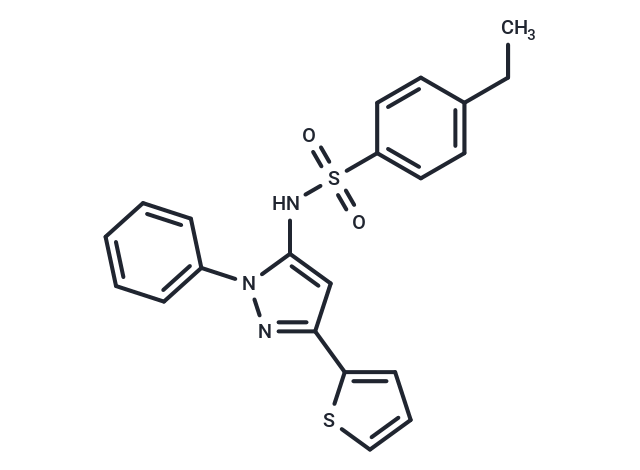Shopping Cart
- Remove All
 Your shopping cart is currently empty
Your shopping cart is currently empty

HSF1A is a cell-permeable activator of HSF1 that protects mammalian cells against stress-induced apoptosis (HSF1).

| Pack Size | Price | Availability | Quantity |
|---|---|---|---|
| 1 mg | $50 | In Stock | |
| 2 mg | $90 | In Stock | |
| 5 mg | $142 | In Stock | |
| 10 mg | $217 | In Stock | |
| 25 mg | $487 | In Stock | |
| 50 mg | $713 | In Stock | |
| 100 mg | $987 | In Stock | |
| 1 mL x 10 mM (in DMSO) | $132 | In Stock |
| Description | HSF1A is a cell-permeable activator of HSF1 that protects mammalian cells against stress-induced apoptosis (HSF1). |
| In vitro | HSF1A is a small-molecule activator that enhances HSF1's ability to protect cells from stress-induced apoptosis by binding to and inhibiting TRiC subunits' activity, crucially without disturbing ATP hydrolysis. When the TRiC complex is genetically inactivated or depleted, HSF1 activation occurs in humans, and HSF1A is found to block the direct interaction between purified TRiC and HSF1 in vitro. Fluorescence anisotropy experiments with FITC-tagged HSF1A demonstrate its strong binding to the Tcp1 subunit of TRiC, with an affinity around 600 nM. This interaction is further supported by titration experiments with purified Tcp1, indicating qualitative validation. Moreover, a significant reduction in the number of cells displaying aggregates is observed at HSF1A concentrations as low as 2 μM, with this fraction consistently declining in a dose-dependent manner. Specifically, pretreatment with 12 μM HSF1A leads to approximately 20% of cells showing aggregates under fluorescence microscopy, highlighting HSF1A's potential in reducing cellular stress markers. |
| In vivo | HSF1A enhances HSF1 activity, stabilizes its expression, and mitigates Doxorubicin (DOX)-induced cardiac damage. In WKY rats treated with DOX (30 mg/kgw) and a combination of DOX and HSF1A (100 mg/kgw/day), HSF1A supplementation significantly restores cardiac function to control levels. Moreover, HSF1A promotes HSF1 nuclear translocation, increases protein chaperone expression, and reduces protein misfolding and cell death in neurodegenerative disease models. Echocardiographic data show that HSF1A also improves cardiac function in the face of DOX-induced impairments. |
| Kinase Assay | Protein extracts are generated from mammalian, yeast and E. coli cultures using biotin-binding buffer (20 mM HEPES, 5 mM MgCl2, 1 mM EDTA, 100 mM KCl, 0.03% NP-40) supplemented with 1% Trition-X100 and protease inhibitors. Approximately 0.5 mg of protein extract is incubated with 100 μM HSF1A-Biotin for 4 h at 4°C and HSF1A-Biotin associated proteins captured by with NeutrAvidin Agarose Resin. After washing in biotin binding buffer proteins are eluted using 50 μL biotin elution buffer (100 mM Tris, 150 mM NaCl, 0.1 mM EDTA, 2 mM D-biotin), resolved on a 4-20% SDS-PAGE, and immunoblotted. For purified TRiC and Hsp70 analyses, 5 nM protein is incubated in biotin-binding buffer+0.5% Triton X-100 with 100 μM biotin or 100 μM HSF1A-Biotin for 4 h at 4°C and captured with NeutrAvidin Resin. For NiNTA purified yeast Tcp1, different concentrations of Tcp1 0.5 μM, 1 mM, 2 mM, 3 mM and 4 mM in 25 mM Hepes pH 7.5, 150 mM NaCl are incubated with 0.5 μM Biotin or HSF1A-Biotin for 4 h at 4°C and captured with NeutrAvidin Resin. |
| Cell Research | PC12 cells seeded into a 96-well plate (5×104 cells/well) are treated with increasing concentrations of HSF1A (2, 4, 8 and 12 μM) for 15 h, at which time httQ74-GFP expression is stimulated by incubation in the presence of 1 μg/mL Doxycycline for 5 d. Cell viability is assessed via the XTT viability assay. |
| Animal Research | RatTen-week-old Wistar Kyoto rats (WKY) are used. The rats are housed at a constant temperature (22°C) on a 12-h light/dark cycle with food and tap water. The animals are arranged into three groups: WKY rats (the control group), DOX rats and DOX rats treated with HSF1A. Each group contain five animals. The DOX group is injected with DOX (5?mg/kg) for 6 consecutive weeks intraperitoneal injection to achieve a cumulative dose of 30?mg/kg, which has been well documented to achieve cardiotoxicity. The small molecular HSF1 activator HSF1A (100?mg/kg/day) is injected intraperitoneally. |
| Molecular Weight | 409.52 |
| Formula | C21H19N3O2S2 |
| Cas No. | 1196723-93-9 |
| Smiles | CCc1ccc(cc1)S(=O)(=O)Nc1cc(nn1-c1ccccc1)-c1cccs1 |
| Relative Density. | 1.31 g/cm3 (Predicted) |
| Storage | Powder: -20°C for 3 years | In solvent: -80°C for 1 year | Shipping with blue ice. | |||||||||||||||||||||||||||||||||||
| Solubility Information | DMSO: 50 mg/mL (122.09 mM), Sonication is recommended. | |||||||||||||||||||||||||||||||||||
Solution Preparation Table | ||||||||||||||||||||||||||||||||||||
DMSO
| ||||||||||||||||||||||||||||||||||||

Copyright © 2015-2025 TargetMol Chemicals Inc. All Rights Reserved.